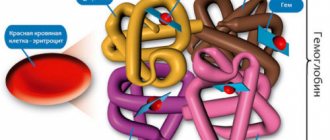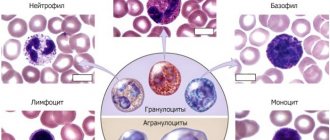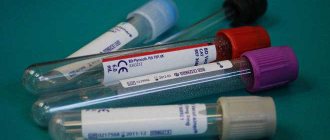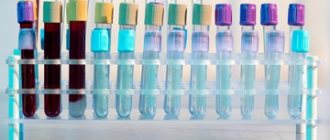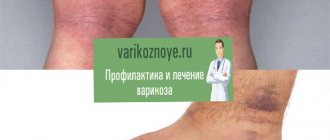A high ESR with normal leukocytes can be considered normal or pathological. ESR is the erythrocyte sedimentation rate. This indicator is determined as part of a blood test. If it is normal, this indicates that there are no inflammatory reactions in the human body. As part of the diagnosis, the leukocyte count with reactive protein should also be taken into account. ESR is also influenced by the quantitative and qualitative composition of erythrocytes.
Analysis transcript
Why there is a high ESR with normal leukocytes, we will find out below. In the meantime, let's find out what the norm is.
The normal ESR value depends most on gender, and also on the age of the person, but in any case, the readings are in fairly narrow ranges. You need to be aware of the following features:
- Newborn healthy children have an ESR of 1 to 2 millimeters per hour. Other values are possible in individual cases. This is directly related to protein changes, as well as increased cholesterol and acidity in the blood. Upon reaching six months of age, this value in children increases to 17 millimeters per hour.
- Older children have rates from 1 to 8 millimeters per hour.
- In men, ESR ranges up to 10 millimeters per hour.
- In women, the normal rate is slightly higher than in men, and reaches 15 millimeters per hour. This is explained by the presence of a certain number of androgens in the female body. It is important to know that this indicator increases during pregnancy and grows, as a rule, until the end of the term, reaching a peak at the time of birth of 55 millimeters per hour. The indicator returns to normal approximately a month after birth. The increase in ESR in this case is explained by a change in the qualitative composition of the blood.
Knowing the ESR indicator allows you to determine the presence of various diseases and prevent their development in time, along with the appearance of complications.
So, why does high ESR occur with normal white blood cells?
What do high ESR values with normal leukocytes mean?
The indicator of high ESR with normal leukocytes provokes a number of questions.
Many people are concerned about such conditions, because when leukocytes are elevated, we are talking about some kind of disease or pathology developing in the body.
At the same time, an increased ESR signals the start of inflammation, which leads to the need for additional tests, so it is important to know what triggered the increase in one component and the preservation of the norm of another.
General information
The protective reaction of the human body, how it will react to foreign agents, most of which are understood as microbes, depends on leukocytes, which are understood as white blood cells.
If we say a few words about the general features of leukocytes, then they capture particles of foreign origin, after which their joint death occurs. In this case, substances with biological activity are released. This in turn causes swelling, redness, pain and fever.
If we are talking about a local inflammatory reaction, which is characterized by an active course, then the death of leukocytes is recorded in large numbers, as a result of which the presence of pus is recorded, and the leukocytes themselves can be divided into several types.
If we are talking about a bacterial and fungal infection, then neutrophils and monocytes come into play; if viruses are present, then a team consisting of lymphocytes and monocytes comes to the aid of the body; eosinophils manifest themselves in the fight against allergies.
Interpretation of tests for TORCH infections 1478
At the same time, the analyzes also indicate the type of neutrophils, which helps in determining the age of the cell. If the analysis shows more rod cells, that is, young cells, then we are talking about an active inflammatory process.
Erythrocyte sedimentation rate is an important indicator that demonstrates the ability of red blood cells to stick to each other and fall to the bottom of the test tube. The presence of inflammatory proteins may increase the rate. First of all, we are talking about fibrinogen.
Inflammation is often associated with an increased red blood cell rate, although the increased number may also be due to other reasons.
Speaking about what the ESR norm is, it is worth emphasizing that it depends on age and gender characteristics, however, the ESR indicators in the blood themselves show fairly narrow ranges.
Thus, in healthy newborns, red blood cell attaches to red blood cell and settles at a rate of 1-2 mm/hour. In some cases, you may encounter other indicators. This is associated with protein changes, increased blood cholesterol or increased acidity. ESR becomes elevated in children aged six months. The indicator reaches 12-17 mm/hour.
If the norm for older children is considered, then the indicator should be in the range of 1-8 mm/h. For men, figures from 1 to 10 mm/h are typical, for women a higher level is from 2 to 15 mm/h. This higher rate is explained by the presence of androgens in the blood of women.
It is important to emphasize that this indicator is irrelevant for pregnant women, since the level increases significantly, especially at the beginning of the second trimester. By the time of birth, its level is within the figures of 55 mm/h. A month after birth, the ESR drops to the previous norm.
ESR and leukocytes: connection
When a disease appears in the human body in its acute form, changes occur that also affect the peripheral blood, which results in the presence of an increased ESR and leukocytes also grow. This combination completely depends on what stage the disease is in and what type it belongs to.
So, if leukocytes are elevated due to their neutrophil components, a person suffers from a bacterial infection, and some oncological problems, heart attack and a number of other pathologies also manifest themselves. If the leukocyte norm has decreased, then we can talk about influenza, tuberculosis, typhoid fever and metastases to the bone marrow. Of course, this is not the entire list of suspected pathologies.
If the rate of leukocyte production is not reduced, but increased, then it is worth checking for the presence of helminthic infestations and ruling out the presence of allergies. The growth of large granular leukocytes is characteristic of an organism suffering from problems with the thyroid gland, tumors of both malignant and benign nature. This deviation can be caused by excessive use of medications and alcohol.
An increase in the rate of leukocytes, their granular form, is a sign of infectious problems: pneumonia, malaria, tuberculosis. It is important to exclude metastasis and cancer in this case and a number of additional diseases. With the rapid growth of leukocytes, we can talk about the presence of syphilis, viral hepatitis, and mononucleosis.
If leukocytes and ESR increase simultaneously, this may be a sign of a period observed after injury or surgery. This is how the body reacts to the presence of large-scale burns and massive blood loss and poisoning. Sometimes this is a sign of the first stage of radiation sickness.
Usually, when the infection subsides, the body first tries to reduce the white blood cell count, and the ESR may be higher than normal. In such cases, there is no reason to worry; this is a characteristic delay. The body will simply need a little more time to put itself in order.
ESR, hemoglobin and leukocytes
ESR and low hemoglobin are a condition that requires additional diagnostic testing. In a general blood analysis, you can encounter such a combination in the presence of various types of anemia.
However, it is important to exclude cancerous lesions, pathologies of a rheumatic and renal nature.
As part of some chronic inflammations, there may be an increase in the indicator, while the number of red blood cells and hemoglobin does not change.
The combination of increased hemoglobin and ESR occurs in various diseases or against the background of exposure to certain factors. We can talk about:
- increased glucose in obesity;
- diabetes mellitus of the first and second types;
- hemolytic anemia;
- a number of oncological processes.
People with increased amounts of vitamins B12 and B9 in the blood, women during pregnancy and the lactation period, girls during menstruation, people living in the mountains, and athletes who often experience increased stress may encounter such indicators.
It is worth noting that when leukocytes are normal and ESR is elevated, we may be talking about problems that are not associated with diseases. In some cases, there are deviations that do not pose a danger to the body.
We are talking about the individual characteristics of the body. About four and a half percent of people on the planet have a higher than normal rate of red blood cell sedimentation. Some medications and vitamins can affect the analysis. Pregnancy has already been mentioned above as a natural physiological process that increases the level of ESR.
Low hemoglobin levels due to poor iron absorption or anemia can also affect the resulting ESR level.
In boys aged 5 to 12 years, deviations in results from the norm are periodically observed without the presence of problems in the body.
It is important to emphasize that the ESR indicator depends on others in the body. And sometimes its increased level is only a reflection of a violation elsewhere.
Pathological problems
However, in many cases, such test results indicate the presence of diseases, including very serious ones. One of the main reasons is infection. This is the most common cause of elevated ESR in the presence of a normal leukocyte level. In this case, the indicator may be above 100 mm/h.
The cause of such deviations may also be oncological problems; the presence of tumors of both benign and malignant types is often detected in this situation. Children also face the same clinical picture, but this does not always indicate oncology.
According to the test results, intoxication can provoke corresponding problems, within the framework of which poisonings of various natures are assumed. These include poisoning due to a cold, and ailments of a rheumatological nature. In this case, the blood becomes thicker.
Indicators at the level of 100-120 mm/h can be observed with kidney problems or diseases of the tract that excrete urine. A blood disease, anisocytosis, cannot be ruled out. In this case, the ESR always shows very high levels, and material metabolism is disrupted. It is worth noting that the results can go astray in both directions, showing very low values.
Testing for IUI during pregnancy17549
Diseases of the endocrine segment also have a corresponding effect on the body.
Any deviations in the functioning of the thyroid gland, directed towards an increase or decrease in the hormones produced, lead to an increased erythrocyte sedimentation rate.
It is worth noting that these diseases are not considered something out of the ordinary, so the presence of a poor ESR analysis may cause you to be referred for a hormonal check.
There is also a class of diseases such as cardiovascular diseases. If the patient has had a heart attack or stroke, then there is a high ESR that will persist for a long time.
People in the older age group often encounter such diseases, although for them the norm is slightly higher.
Increased viscosity of blood, which forms against the background of poisoning, constipation or intestinal infection, leads to faster sedimentation of red blood cells.
Some dental diseases, such as granulomas, can also have this effect. It is worth noting that ESR is only a subtle hint of the presence of some problem in the human body.
To clarify the diagnosis, a large number of additional studies are required. We are talking not only about blood, but also other biological fluids. Often several ESR levels are checked.
This helps to understand the dynamics and effectiveness of treatment.
newpopulardiscussed
Source: https://1diagnos.ru/laboratornye-issledovaniya/krovi/klinicheskij/vysokoe-soe.html
Main reasons for the increase
An increased ESR may not always indicate the presence of pathology. There are the following situations against the background of which inflated limits of this indicator are the norm:
- The presence of individual characteristics of the functioning of organs. Only a small proportion of the total number of patients has a high ESR. The reasons must be determined by a doctor.
- Some medications and vitamins can affect sedimentation rate.
- Pregnant women are also susceptible to changes in this indicator (their ESR reaches 80 millimeters per hour).
- Iron deficiency in the blood along with its poor absorption in the body. What are other reasons for high ESR with normal leukocytes?
- ESR can increase in boys aged five to twelve years, even if they do not have any pathogenic factors.
- This indicator often increases as part of changes in the quantitative and qualitative composition of the blood.
But often a high ESR with normal leukocytes in a child and an adult indicates that certain pathological processes are occurring in the body.
Causes of increased ESR with normal leukocytes, not related to disease
If the study shows the result that the ESR is increased, this does not always mean that the patient is sick. In some cases, deviations are possible that are not dangerous to the body. These include:
- Individual characteristics of the body. According to statistics, 4.5% of people on the planet have an increased red blood cell sedimentation rate.
- Some medications or vitamins may cause upward changes in analysis.
- Pregnancy. Women who are carrying a child almost always have a high erythrocyte sedimentation rate, sometimes the numbers reach 80 mm/h.
- Iron deficiency, low hemoglobin. Anemia and poor absorption of iron are common causes of inadequate test results.
- Boys aged 5-12 years. From time to time, little boys experience erroneous results when there are no diseases, inflammations or infections in their bodies.
- ESR depends on other indicators of blood components: albumin, fibrinogen proteins, immunoglobulin, various pigments and bile and uric acids.
Common diseases
The most common diseases with elevated ESR include:
- Infectious lesions. Almost half of all reasons for the increase in this indicator are associated with the emergence of an infectious focus. In this case, the indicator can increase to 100 millimeters per hour and higher.
- Neoplasms of various kinds. A tumor is often detected precisely by the presence of a high ESR in the blood in combination with an absolutely normal leukocyte composition. In children, a similar situation may also appear, but it does not indicate a tumor.
- Poisoning the body with various toxins. Intoxication leads to an increased ESR in the presence of normal white blood cells, which can cause blood thickening and leads to very rapid sedimentation of particles. What else does a high ESR mean?
- The presence of diseases that affect the genitourinary system. With such pathologies, the ESR value can range from up to 120 millimeters per hour.
- Presence of anisocytosis. This blood disease increases the ESR rate several times at once.
- The patient has a metabolic disorder. This pathology can increase or decrease the indicator in question.
- The presence of pathologies of the endocrine system. Most of these diseases lead to an increase in this indicator. In this regard, if its boundaries change, it is necessary to visit an endocrinologist. It is important to establish the reasons for high ESR in the blood.
- Getting sick with the cardiovascular system. After a heart attack or stroke, the ESR rate increases noticeably and can remain at this level for quite a long time. Elderly people often face this situation. They need to know their individual acceptable ESR limits in order to avoid any unpleasant consequences.
- Presence of viscous blood. An increase in this indicator invariably leads to an acceleration of erythrocyte sedimentation. Blood viscosity, as a rule, increases against the background of constipation, intoxication, intestinal infections, and so on.
- Against the background of dental diseases. Some diseases that affect the teeth can also cause an increase in the ESR value.
What does it mean if the ESR is normal, but the leukocytes are elevated? Leukocytosis and increased ESR. What it is?
Leukocytes are white blood cells that perform a protective function. They fight foreign bacteria and microbes, destroying them and dying along with them. At this time, a person experiences symptoms such as swelling, fever, and pain. If the infection is severe, pus may ooze from mucous areas.
Leukocytes are divided into three groups, which are responsible for any diseases and pathological processes:
- Neutrophils and monocytes indicate bacterial and fungal lesions.
- Lymphocytes and monocytes – viral infections and antibody production.
- Eosinophils indicate an allergic reaction.
Therefore, in the analysis, attention is paid to the number of old (segmented) and young (band) cells - neutrophils. It is believed that the more new neutrophils there are, the more active the inflammatory process.
ESR determines the ability of red blood cells to stick together and fall to the bottom of the test tube. As a rule, the speed increases in the presence of inflammation, in which case the protein fibrinogen increases. Sometimes the reason for its increase is the physiological characteristics of a person. For example, if a patient has signs of anemia, then there is a decrease in the number of red blood cells in the blood.
It is worth noting that it is possible to identify a disease in a person by studying all the indicators. An increase in any parameter indicates the presence of pathology and provides grounds for additional research.
In case of deviation
A significant difference in the number of leukocytes from the norm does not indicate the presence of any disease, because several factors can affect their increase.
These include:
- onset of menstruation;
- pregnancy;
- postpartum period;
- eating food;
- use of medications;
- blood sampling in the evening.
Therefore, to exclude unreliable results, the test must be taken in the morning on an empty stomach.
A high level of leukocytes is a reason to conduct additional research and find out all the reasons that could affect the results.
There are three categories of diseases in which an increase in leukocytes is detected:
- Acute and chronic infectious diseases.
- Malignant tumors (highest indicator).
- Inflammatory processes: rheumatism, lupus.
A detailed blood test helps calculate changes in the leukocyte formula.
Thanks to it, the doctor will be able to recognize whether there is a viral or bacterial infection in the body, or maybe it is influenced by an allergic process.
Then the patient is examined, additional examinations of urine and feces are prescribed, and X-rays, ultrasound, and MRI are possible. Only after this, after comparing all the data, a diagnosis of the disease is made.
Erythrocyte sedimentation in the body is an important indicator, but the disease is not determined by this value alone. Therefore, other analysis information must be taken into account. An elevated ESR can be affected by various reasons: pregnancy, anemia, the presence of parasites, consumption of fatty foods.
What is the normal ESR rate for children?
From birth to 5 years, the ESR norm in children is:
o from birth to 2 months – 0-2 mm/h;
o from 2 months to a year – 2-10 mm/h;
o from one to 5 years – 5-11 mm/h;
o from 5 years and older – 4-12 mm/h.
An indicator in children of 15 mm/h is considered dangerous. In this case, you should seek help from a doctor.
Elevated ESR syndrome
Sometimes it happens that the erythrocyte sedimentation rate is at a high level for a long time. There are no other symptoms or complaints, and the person feels well.
In this case, comprehensive examinations are carried out to find the cause of the condition. If no pathologies are identified, they sometimes talk about “increased ESR syndrome.” Indicators can sometimes reach 50–60 mm/h. This condition cannot be called a disease.
Rather, it is an individual feature of the child’s body.
Analysis of urine
No less informative is a urine test. It is taken both during routine medical examinations and to assess health status during illness. The indicators that are assessed during the analysis are:
- color - golden or straw yellow;
- transparency - normally urine is always clear;
- density - 1010-1024 g/l;
- foaminess - when shaken, an unstable transparent foam is formed;
- smell - corresponds to the disease, for example, with phenylketonuria, the smell of mouse urine;
- acidity - PH 5.0-7.0;
- the presence of protein is considered a deviation from the norm of more than 0.033 g/l.
False increase in ESR
In some situations, changes in indicators do not indicate a pathological process, but some chronic conditions. The level of ESR can increase with obesity and acute inflammatory process. Also, false changes in ESR indicators are observed:
- With elevated blood cholesterol levels.
- Due to the use of oral contraceptives.
- Subsequently, vaccination against hepatitis B.
- With long-term intake of vitamins that contain large amounts of vitamin A.
Medical research shows that ESR can often increase in women for no reason. Doctors explain such changes by hormonal imbalances.
ESR, hemoglobin and leukocytes
ESR and low hemoglobin are a condition that requires additional diagnostic testing. In a general blood analysis, you can encounter such a combination in the presence of various types of anemia.
However, it is important to exclude cancerous lesions, pathologies of a rheumatic and renal nature.
As part of some chronic inflammations, there may be an increase in the indicator, while the number of red blood cells and hemoglobin does not change.
The combination of increased hemoglobin and ESR occurs in various diseases or against the background of exposure to certain factors. We can talk about:
- increased glucose in obesity;
- diabetes mellitus of the first and second types;
- hemolytic anemia;
- a number of oncological processes.
People with increased amounts of vitamins B12 and B9 in the blood, women during pregnancy and the lactation period, girls during menstruation, people living in the mountains, and athletes who often experience increased stress may encounter such indicators.
It is worth noting that when leukocytes are normal and ESR is elevated, we may be talking about problems that are not associated with diseases. In some cases, there are deviations that do not pose a danger to the body.
We are talking about the individual characteristics of the body. About four and a half percent of people on the planet have a higher than normal rate of red blood cell sedimentation. Some medications and vitamins can affect the analysis. Pregnancy has already been mentioned above as a natural physiological process that increases the level of ESR.
In boys aged 5 to 12 years, deviations in results from the norm are periodically observed without the presence of problems in the body.
It is important to emphasize that the ESR indicator depends on others in the body. And sometimes its increased level is only a reflection of a violation elsewhere.
The need for additional examination
It is worth noting that a high level of ESR only suggests the presence of some disease, but never determines it. To do this, you need to consult a doctor who will prescribe additional research, and in addition, make a diagnosis, after which he will determine a further therapeutic course.
As treatment progresses, it is necessary to conduct several tests after certain time intervals, which will allow you to track how much the value has changed since its increase. Based on this information, the specialist can reduce or increase the dose, replace medications if necessary, and carry out all necessary therapeutic procedures.
High ESR in a child
In young children, the rate of subsidence may increase for the following reasons:
- The influence of improper breastfeeding (in this case, red blood cells will settle much faster due to maternal neglect of the diet).
- Impact of parasitic lesions.
- Teething (this process causes a restructuring of the child’s entire body, and therefore the rate of sedimentation increases).
- The baby is afraid to donate blood.
How does teething affect the blood formula?
During teething, children's immunity decreases, and against this background, the child's body is most susceptible to attack by viruses. The child has itchy gums, hypersalivation, he puts everything in his field of vision into his mouth.
Naturally, microorganisms entering the oral mucosa multiply, leading to an infectious process in a small organism. Teething itself cannot change the blood picture, but if during this period the child catches an infection, then there will be an increase in ESR, and leukocytes may be increased.
Perhaps the most common complications during teething are changes in the child’s behavior; he becomes capricious and whiny. At the same time, appetite is disrupted, the baby even refuses his favorite treats. Problems also arise with sleep; it is short-lived with frequent awakenings.
Increase above 100 mm/h
The indicator exceeds the level of 100 m/h in acute infectious processes:
A significant increase in the norm does not occur overnight; ESR increases for 2–3 days before reaching a level of 100 mm/h.
Methods for analyzing ESR levels
There are two ways to conduct research: the Panchenkov method and the Westergren method.
For research using the Panchenkov method, several ml of blood is required, which is taken from the ring finger. The taken material is mixed with sodium citrate and after one hour the result is compared with the identification scale.
When using the Westergren method, blood for analysis is taken from a vein. The blood is mixed in a special vessel with reagents, and the resulting mixture is poured into a special test tube. There is a scale on the tube that allows you to determine the rate at which red blood cells settle. This method is considered modern and reliable.
What does a low ESR level mean?
Low rates do not indicate serious abnormalities and diseases. But if the indicator in the baby’s analysis is greatly underestimated, pay attention to the child’s well-being.
Perhaps he lacks nutrients in his diet or his diet is not well balanced. Such indicators occur after food poisoning, when the body loses a lot of fluid due to diarrhea and vomiting.
Sometimes low ESR occurs in diseases of the blood and circulatory system. In this case, all the child’s blood test parameters are changed.
Common diseases
The most common diseases with elevated ESR include:
- Infectious lesions. Almost half of all reasons for the increase in this indicator are associated with the emergence of an infectious focus. In this case, the indicator can increase to 100 millimeters per hour and higher.
- Neoplasms of various kinds. A tumor is often detected precisely by the presence of a high ESR in the blood in combination with an absolutely normal leukocyte composition. In children, a similar situation may also appear, but it does not indicate a tumor.
- Poisoning the body with various toxins. Intoxication leads to an increased ESR in the presence of normal white blood cells, which can cause blood thickening and leads to very rapid sedimentation of particles. What else does a high ESR mean?
- The presence of diseases that affect the genitourinary system. With such pathologies, the ESR value can range from up to 120 millimeters per hour.
- Presence of anisocytosis. This blood disease increases the ESR rate several times at once.
- The patient has a metabolic disorder. This pathology can increase or decrease the indicator in question.
- The presence of pathologies of the endocrine system. Most of these diseases lead to an increase in this indicator. In this regard, if its boundaries change, it is necessary to visit an endocrinologist. It is important to establish the reasons for high ESR in the blood.
- Getting sick with the cardiovascular system. After a heart attack or stroke, the ESR rate increases noticeably and can remain at this level for quite a long time. Elderly people often face this situation. They need to know their individual acceptable ESR limits in order to avoid any unpleasant consequences.
- Presence of viscous blood. An increase in this indicator invariably leads to an acceleration of erythrocyte sedimentation. Blood viscosity, as a rule, increases against the background of constipation, intoxication, intestinal infections, and so on.
- Against the background of dental diseases. Some diseases that affect the teeth can also cause an increase in the ESR value.
Normal indicators of ESR, leukocytes and lymphocytes in the child’s blood
What is ESR?
Erythrocyte sedimentation rate is a laboratory indicator that reflects the ratio of plasma protein fractions. The density of erythrocytes is much higher than the density of plasma and therefore they settle to the very bottom of the test tube, and the speed with which they do this is an information indicator.
Source: https://GolovaNeBoli.ru/krov/lejkotsity-povysheny-soe-v-norme.html
The need for additional examination
It is worth noting that a high level of ESR only suggests the presence of some disease, but never determines it. To do this, you need to consult a doctor who will prescribe additional research, and in addition, make a diagnosis, after which he will determine a further therapeutic course.
As treatment progresses, it is necessary to conduct several tests after certain time intervals, which will allow you to track how much the value has changed since its increase. Based on this information, the specialist can reduce or increase the dose, replace medications if necessary, and carry out all necessary therapeutic procedures.
Decreased white blood cells
A few words about low leukocyte levels. This is a situation that always requires certain diagnostic maneuvers, since suppression of hematopoiesis is a rather serious symptom. Therefore, the advice here is very simple: if your white blood cells are below normal, go to the doctor. The diagnostic path may not be very simple, but it must be followed.
By the way, one of the reasons for the decrease in leukocytes may be, oddly enough, headache pills. Yes, yes, banal analgesics, when taken frequently and regularly, can inhibit bone marrow function. Don't forget about this, those who swallow painkillers by the handful.
A young woman arrives. There is nothing to worry about, only the leukocytes in the blood test are low. In several repeated tests the indicator was <2 thousand/µl. There are no other obvious complaints. I invite a hematologist to a consultation and ask in more detail. Sometimes headaches bother me.
— Painkillers? Well, yes, I take it sometimes: analgin and other various analgesics that are sold in pharmacies. Often, yes, almost every day.
A full hematological examination was carried out, including a bone marrow puncture, and, fortunately, nothing wrong was found. I was forbidden to take painkillers, and after a couple of months my blood counts recovered.
Over-the-counter analgesics are not a toy. Drugs based on metamizole (analgin, baralgin, etc.), although rare, can cause very severe bone marrow damage.
But chronic headaches must be treated completely differently.
High ESR in a child
In young children, the rate of subsidence may increase for the following reasons:
- The influence of improper breastfeeding (in this case, red blood cells will settle much faster due to maternal neglect of the diet).
- Impact of parasitic lesions.
- Teething (this process causes a restructuring of the child’s entire body, and therefore the rate of sedimentation increases).
- The baby is afraid to donate blood.
ESR 23 in a woman and a man - what does it mean?
Content
- 1. Reasons, norms
- 2. Anemia
- 3. Leukocytes and ESR
ESR can often be slightly elevated to 23 mm/h, especially in women, what does this mean? From time to time, the doctor sends each of us for a general blood test. The results obtained provide important information about the state of the body, help make a diagnosis or confirm recovery. But then the doctor tells the woman: “Your ESR is 23.” Or she herself sees this figure on the form where the results are printed. Nearby, normal values are indicated in parentheses, and the patient understands that her numbers are higher than necessary. Let's figure out why this could happen.
Reasons, norms
The limits of normal ESR values are somewhat different for men and women. In representatives of the stronger sex they are slightly lower - 2-10 mm/h, in women, respectively - 2-15 mm/h.
First, let’s make a reservation that test results, in particular, erythrocyte sedimentation rate indicators, may also depend on “technical” issues not related to health.
The numbers may change if:
- the laboratory assistant did not prick his finger too deeply, and the blood had to be squeezed out, while crushing the red blood cells;
- the patient had breakfast before taking the test;
- the reagent was not very fresh;
- the process of determining the results took place in a room where it was too cold or hot;
- In the morning, the erythrocyte sedimentation rate in people is slightly higher than at other times of the day.
But, let’s say, all the necessary conditions were met, but the ESR was still increased. But insignificantly – up to 23 mm/h. Is the woman sick or healthy? ESR indicators directly depend on the woman’s age.
They can fluctuate within the following limits:
- 14-30 years – from 4 to 15 mm/h;
- 30-50 years – from 8 to 25 mm/h;
- over 50 years old - from 12 to 53 mm/h.
In addition, a deviation in one direction or another by 2-3 digits is also not critical. Let’s say if a lady is 35 years old and the ESR is 27, then this should not cause much concern. The male body also changes with age - the erythrocyte sedimentation rate increases slightly.
What is the norm for children and adolescents?
You can focus on the following numbers:
- in children 2-5 years old – 5 – 11 mm/h;
- in children 6 -13 years old - 4 - 12 mm/h;
- in teenage girls 14 - 17 years old - 3 - 17 mm/h.
In addition, an increase may occur in the presence of allergic reactions, diseases of the endocrine system, and metabolic disorders. Excess weight can also affect ESR.
Pregnant women deserve special attention. Their ESR can range from 20 to 45 mm/h. And this will not be a pathology. The body is simply being rebuilt, which is reflected in the blood test.
There is no need to worry too much if the indicators are increased by only a few units. Also, during pregnancy, or if you reach old age, these numbers may become higher than usual.
Anemia
If the ESR is slightly elevated, the doctor will pay attention to other indicators in the analysis form. They can provide an invaluable clue as to why the erythrocyte sedimentation rate has increased.
It is especially worth highlighting one of the common causes - iron deficiency anemia. Today this diagnosis can be made to many women. An unbalanced diet, heavy periods - and hemoglobin drops below normal. The fewer red blood cells there are in the blood, the faster they will settle to the bottom of the test tube.
If a woman’s hemoglobin is below 120, and ESR fluctuates between 20-29 mm/h, anemia is most likely to blame for its increase.
Symptoms by which a woman may suspect she has anemia:
- rapid heartbeat;
- constant feeling of fatigue;
- shortness of breath even with little physical activity;
- decreased performance.
If you have anemia, your doctor will recommend taking iron supplements. Along with the cure, the blood test also normalizes.
An indicator such as the number of leukocytes is also of great importance. Let’s say that a myocardial infarction is characterized by the “scissors symptom.” If a heart attack occurs, the number of leukocytes begins to increase rapidly, but the ESR remains the same. After a few days, the number of leukocytes decreases and the ESR increases.
If both leukocytes and erythrocyte sedimentation rate are elevated, the doctor will begin to look for an inflammatory process. Wherever the source of inflammation is located in the body, it can give exactly this picture of the blood. This could be, for example, sinusitis or pelvic organ disease.
ESR may be increased in the following cases:
- There is a systemic disease, for example, polyarthritis.
- The kidneys, liver, and intestines are not in order.
- You recently had surgery.
- There is an infectious disease.
- Bronchitis or other seasonal illness.
- Boils and other inflammatory skin diseases.
Remember that ESR, unlike C-reactive protein, gives a slower reaction. In case of illness, the ESR value may not rise so quickly. But after recovery, when C-reactive protein has already dropped to normal values, ESR may remain elevated for some time.
23 mm/h may indicate recovery from an infectious or viral disease.
Almost all people to some extent experienced symptoms of cancerophobia, that is, they were afraid of cancer. Many have heard that high ESR rates are characteristic of such patients.
This is true. But malignant diseases, including blood diseases, usually give significantly higher rates - from 40 and above. These figures are especially high for multiple myeloma – 80-100 mm/h.
In cases of cancer, ESR increases significantly. In addition, with cancer, characteristic changes are detected in other indicators of the CBC (complete blood count).
Which doctor should you contact if you are alarmed by the results of a blood test? You can start with a local therapist. A hematologist will answer your questions in more detail.
If an examination is prescribed, but as a result of it the reasons for the increase in ESR are not identified, you will be asked to repeat the blood test after a certain time to see how the ESR indicators change over time. The number has decreased - everything is fine. If it has grown, the doctor will prescribe additional diagnostic tests.
We recommend reading:
boleznikrovi.com
Determining the result
The level of erythrocyte sedimentation is currently determined in three different ways:
- The Westergren method involves venous sampling of biomaterial, which is subsequently mixed with sodium citrate. After one hour, all deposited red blood cells must be measured.
- As part of the Winthrop method, blood is mixed with an anticoagulant, after which the biomaterial is placed in a test tube with divisions. But the test tube may become clogged if the sedimentation rate is more than 60 millimeters per hour (this, of course, makes it very difficult to establish the exact sedimentation level).
- The Panchenkov method of determination involves taking blood for testing from a finger. Next, the biomaterial is combined with sodium citrate.
All of the above calculation methods are manual. Different methods are good in certain cases. The Westergren method of calculating subsidence is often the most accurate. With the development of medicine, ESR began to be calculated automatically, since this method completely eliminates the occurrence of errors in calculations.
Determination of ESR and subtleties of the study
You also need to know that leukocytes play a very important role in the process of determining sedimentation rate. Normal leukocytes in the presence of elevated ESR may indicate residual effects after the disease. As for a reduced level of leukocytes, this indicates viral sources of the disease, and an increased level indicates the presence of bacterial pathogens.
Reanalysis
If you have doubts about the correctness of the test performed and the calculation of the final results, you should apply for a repeat blood test at any paid clinic. Currently, there is an alternative method for determining the subsidence rate. This technique is used exclusively in paid clinics due to expensive equipment.
Today in medicine, determining the level of ESR plays a very important role in the treatment of various diseases, since it acts as an indirect or direct sign that indicates the presence of a certain pathology in a patient. An experienced doctor can easily recognize the disease using additional diagnostic techniques and prescribe the necessary course of therapy.
Thus, a high ESR in the presence of a normal leukocyte value usually provokes a number of questions. Many people are concerned about this condition, because when leukocytes increase, we are talking about some specific disease developing in the body.
ESR is higher than normal, what does this mean?
ESR, or erythrocyte sedimentation rate (reaction), is a diagnostic, not a specific indicator, that is, it does not indicate a specific disease. If the ESR is higher than normal, this means that there is reason for a more detailed medical examination. An ESR within the normal range is not considered evidence of the absence of health problems, just like an increased or decreased ESR. Being the only deviation from the norm in a clinical blood test, it does not indicate the presence of the disease.
The reasons for increased ESR in the blood are numerous. They are divided into groups:
- In 39% of cases, increased ESR in the blood is caused by bacterial and viral infections. These include infectious and inflammatory diseases of the upper respiratory tract (acute respiratory infections, pneumonia, bronchitis, sinusitis, etc.), infections of the genitourinary system (pyelonephritis, cystitis, prostatitis), fungal infections, viral hepatitis, tuberculosis. This usually occurs against the background of leukocytosis, but if the level of leukocytes is normal, a high ESR may be a consequence of other diseases. In chronic hepatitis, a sharp jump in ESR is regarded as a transition of the disease to the active phase.
- In second place in terms of prevalence (23%) are oncological diseases, malignant neoplasms in which are localized in the lungs, bronchi, kidneys, pancreas and prostate glands, and female organs. Much less often, ESR increases in hematological malignant processes (although in these cases blood clotting is impaired): leukemia, lymphoma, myeloma. Typically, in oncology, ESR can increase to 60 mm/h. If the ESR is increased and the leukocytes are within normal limits, the tumor may affect the bone marrow.
- Rheumatological diseases account for 17% of cases of elevated ROE. This group includes systemic immune diseases: rheumatoid arthritis, lupus erythematosus, temporal arteritis.
- If we classify kidney diseases as a separate group (glomerulonephritis, pyelonephritis, nephrotic syndrome), then they account for 3% of cases. With congenital and acquired kidney pathologies, the excretory function is disrupted, resulting in a change in blood composition.
In all of the above cases, ESR can increase significantly, up to 100 mm/h.
When figuring out why the ESR in the blood is increased, it is necessary to take into account that in infectious diseases the increase does not begin from the very beginning of the disease, but after recovery the ESR can remain above normal for 1-2 months.
Erythrocyte sedimentation rate is increased: what does this mean? Other reasons for this increase, which account for 18% of the total number of recorded cases, include:
- anemia of various origins;
- conditions after surgical interventions and injuries;
- cholecystitis, pancreatitis;
- endocrine pathologies (diabetes);
- increased blood cholesterol levels;
- pregnancy;
- taking hormonal contraceptives;
- violations of the analysis technique (the temperature in the room where the blood tubes are stored should not exceed 27˚C);
- insufficient nutrition (church fasting or strict diet);
- overweight (obesity);
- vaccines and vaccinations.
Oral contraceptives cause an increase in blood viscosity and increase the risk of blood clots. The degree of blood thickness is one of the main factors influencing ESR indicators.
Low hemoglobin often leads to an increase in ESR. At the same time, the number and shape of the red blood cells themselves change.
The causes of elevated ESR in women are often associated with pregnancy. As a result of hormonal changes and fluctuations occurring in the female body, ESR almost always increases. As a rule, the increase in ESR levels during pregnancy begins in the second trimester. About a week after birth, the erythrocyte sedimentation rate returns to normal. The same thing is observed during lactation.
However, if the erythrocyte sedimentation rate exceeds 30-40 mm/h, some pathology may be the cause. High ESR on the background of low hemoglobin requires corrective therapy.
ROE is higher than normal - what does this mean: based on the deviation of one indicator in the blood composition, assessing the state of health is very difficult. If, as a result of additional research, the reasons for the increase are not found, and there are no other symptoms of any serious diseases, then there is no significant cause for concern. You need to monitor your ROE level once every six months.
If the ESR is higher than normal, this means that this condition itself is not subject to special treatment. If, during a comprehensive examination, any pathological process or disease is identified, then that is what is treated. After adequate treatment, clinical blood test values will gradually return to normal.
1 Comment
kod-zdorovya.ru
